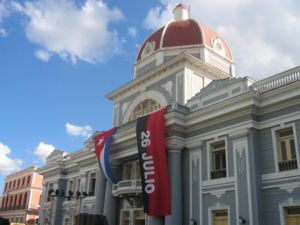Today we recall the most revered date in Cuba’s history. For it was on this day, 26th July 1953, that Fidel Castro led the failed attack against the corrupt Fulgencio Batista dictatorship that would serve as the namesake and inspiration for the twentieth-century’s most successful national revolution.
Under Batista’s corrupt and incompetent leadership, 43% of Cuba’s rural population was illiterate, 60% lived in huts with earth floors and thatched roofs, typhoid and tuberculosis was endemic, while the United States controlled nearly all of its industry. But beyond Havana’s intelligentsia, there was no popular unrest. Fidel Castro knew he had to do something spectacular to wake and rally the masses. Timed to correspond with the centennial of the birth of independence hero José Martí, Castro, his brother Raul and 150 fellow revolutionaries launched an attack on the famous Moncada Barracks in eastern Cuba. The group formed a sixteen-automobile caravan to give the appearance of a delegation headed by a high-ranking officer. But the plan was a spectacular disaster from the get-go. The convoy was separated en route and the vehicle carrying most of the weapons went missing. Upon arriving at the barracks, Castro lost control of his car and crashed into a group of soldiers on duty at the gate. The element of surprise well and truly gone, half of the guerrillas were killed in the ensuing shoot-out while the rest were captured – including the Castro brothers.
As news spread of the dramatic attack and ferocious military response, the audacity and ideals of the young revolutionaries sparked the imagination of the Cuban people – just as Castro had hoped and predicted. The Batista government succumbed to public pressure agreeing to a trial rather than executing the captured rebels. 27-year-old Fidel Castro – a qualified lawyer – elected to defend himself. Incarcerated and without the aid of books, legal papers or counsel, he penned an extraordinary 4-hour plea: from Cromwell and the English Civil War, to the French, American and Russian revolutions, and on to Rosseau, Milton, Locke and Thomas Paine before focusing specifically on Cuba’s social dilemmas and injustices, Castro recounted from memory the history of humanity’s struggle against tyranny. The result was one of the most astonishing and brilliant revolutionary treatises of the twentieth century, concluding with the immortal lines: “Condemn me; it does not matter. History will absolve me.” He was sentenced to fifteen years.
Castro’s trial captivated the nation. As his name and message spread like wildfire across Cuba, the Batista government remarkably once again yielded to public pressure and released him after only two years. The Moncada attack had been a total fiasco. But Fidel Castro emerged from it a national figure, replete with a legendary manifesto and a rousing name for his revolution: The 26th of July Movement. He went into exile in Mexico, where he met the Argentine Ernesto “Che” Guevara.
Just five-and-a-half years after the Moncada assault, Castro’s guerrillas would march triumphantly into Havana.
“Men do not shape destiny. Destiny produces the man for the hour.” – Fidel Castro



4 Responses to 26th July 1953 – the Birth of the 26th of July Movement